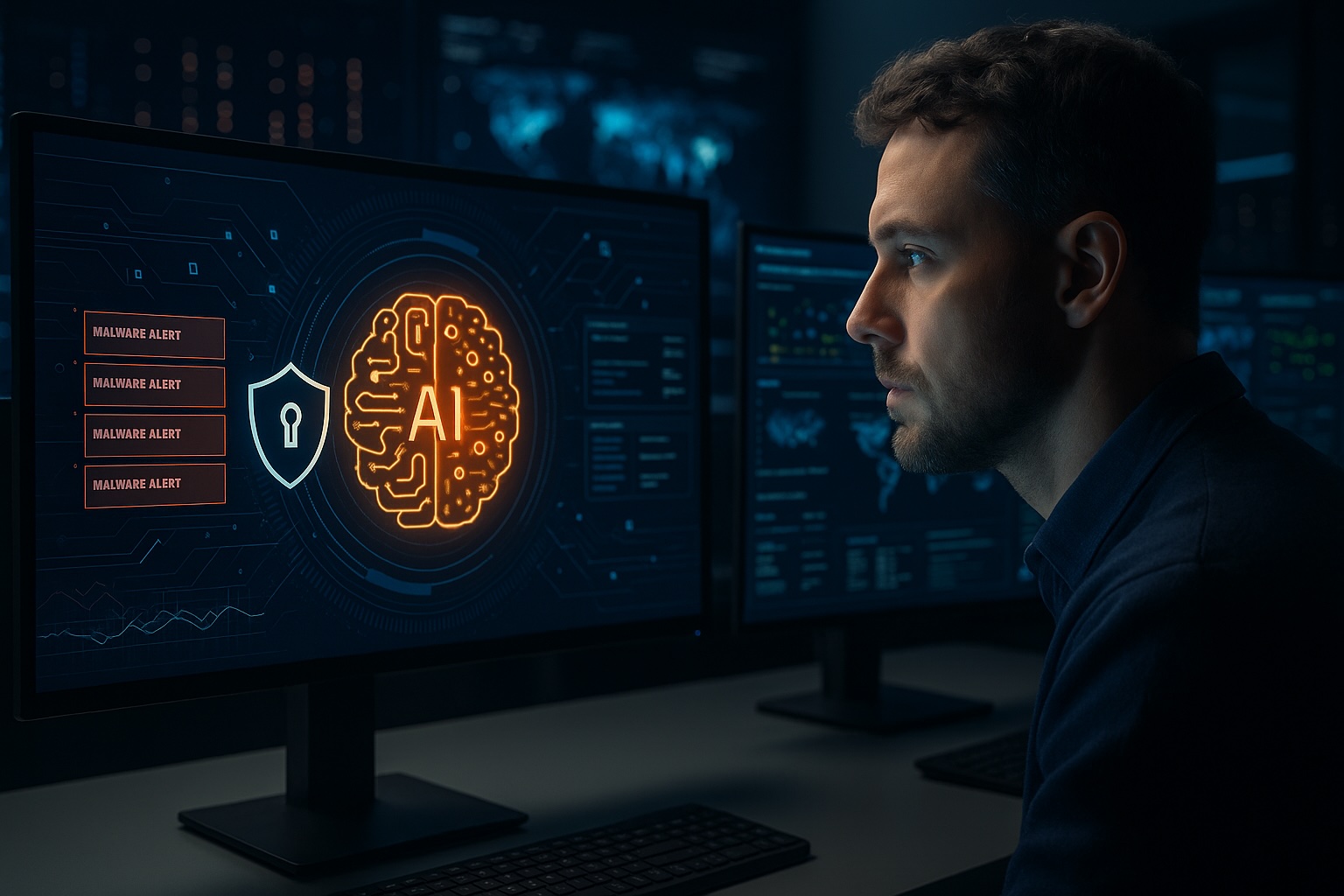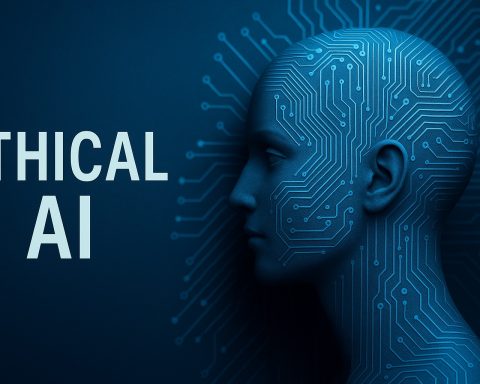AI-Powered Cybersecurity
Overview: AI (especially machine learning) is transforming cybersecurity by automating analysis of vast data. Modern security systems use AI to continuously scan network logs, user behavior, and system events for anomalies. AI algorithms learn “normal” patterns and flag deviations (like unusual file behavior or login attempts) much faster than humans sophos.com paloaltonetworks.com. For example, an AI-driven dashboard may display alerts (as illustrated below) whenever it detects suspicious traffic. This helps analysts focus on true threats instead of wading through thousands of routine alerts. Crucially, the same AI techniques are used by both defenders and attackers: cybercriminals are already applying machine learning and automation to launch large-scale, targeted attacks sophos.com. This creates an ongoing “arms race” where defenders increasingly rely on AI to keep pace.
Figure: Illustration of AI-driven threat monitoring – automated systems flag malware alerts in real time. AI tools can process and correlate data far beyond human ability. They analyze logs and traffic flows at scale, detect subtle patterns, and recognize malicious behaviors even if signatures are unknown sophos.com paloaltonetworks.com. In practice, this means AI can spot a “needle in a haystack” – such as a hidden backdoor or a rare data exfiltration pattern – that would evade traditional rule-based scanners. Over time, AI models learn from each detected attack, improving their predictive accuracy. In effect, AI turns cybersecurity from a static, manual process into a dynamic, self-improving defense.
Benefits and Advancements
AI brings several key advantages to cyber defense. In short, it makes detection faster, more accurate, and less tedious:
- Rapid data analysis: AI can sift through petabytes of logs, emails, and network flows in seconds, finding anomalies that no human team could review manually sophos.com sophos.com.
- Anomaly and threat detection: Machine learning excels at spotting odd patterns (e.g. a workstation suddenly uploading large files at 3AM). Unlike signature-based tools, it can recognize novel or polymorphic malware by its behavior sophos.com sophos.com.
- Automation of routine tasks: Mundane tasks like triaging alerts, classifying malware, or scanning for vulnerabilities can be automated. This frees up security staff to focus on investigation and strategy sophos.com sophos.com. For example, an AI engine may automatically quarantine a suspicious endpoint or apply a software patch without human intervention.
- Speed and scale: AI makes detection and response near real-time. A 2024 report notes that AI-driven systems can flag ransomware or intrusion attempts as soon as they start, minimizing damage sophos.com. In practice, organizations using AI have dramatically cut their “dwell time” (how long an attacker lurks) compared to traditional methods.
- Continuous learning: Modern AI models continuously update from new data. They learn from each cyber incident, adapting to evasion tactics. Over time, this leads to enhanced accuracy – fewer false positives and better coverage against emerging threats bitlyft.com sophos.com.
In short, by automating analysis and learning from data, AI augments human defenders. One industry summary emphasizes that AI-driven security is now “proactive,” continuously predicting and countering threats rather than passively waiting for alerts advantage.tech. This “predict-before-detect” approach represents a major advancement: rather than patching holes after an exploit, AI can identify vulnerable patterns in code or behavior and suggest fixes in advance.
Risks and Vulnerabilities
AI also introduces new security risks. Attacks can target the AI itself, and cybercriminals can misuse AI to amplify their campaigns. Key vulnerabilities include:
- Adversarial attacks on AI: Malicious actors can craft inputs that fool or evade machine learning models paloaltonetworks.com securitymagazine.com. For example, by subtly modifying a malware’s code or a network packet, an attacker may cause an AI detector to miss the threat. These adversarial examples exploit blind spots in how the model learned. In practice, researchers have shown that tiny changes invisible to humans can flip an AI’s decision. Defending against this requires techniques like adversarial training (re-training models on these deceptive inputs) paloaltonetworks.com, but this remains a significant challenge paloaltonetworks.com securitymagazine.com.
- Data poisoning and model theft: AI models need large training datasets. If an attacker poisons this data (e.g. injecting bogus or malicious samples), the AI can learn wrong patterns and become unreliable securitymagazine.com. Alternatively, if an attacker steals an organization’s AI model or its parameters, they gain valuable intel (intellectual property) and may manipulate its behavior securitymagazine.com. For example, by learning a spam filter’s model, a hacker could reverse-engineer which words evade detection. This compromises both security and privacy.
- AI-enabled cyber attacks: Just as defenders use AI, attackers use it too. Generative AI can create highly convincing phishing emails, deepfake videos, and malware variants. For instance, underground tools now use ChatGPT or Google’s Gemini to generate personalized phishing campaigns at scale foxnews.com. In one documented case (early 2024), attackers used real-time deepfake video and voice to impersonate a company’s CEO over Zoom, tricking an employee into wiring $20M to a scam account foxnews.com. AI-driven botnets can coordinate distributed attacks more efficiently, and AI can find and exploit new vulnerabilities faster. In sum, AI dramatically amplifies attackers’ abilities securitymagazine.com foxnews.com.
- Privacy and data leakage: AI systems often require sensitive data (user info, system logs) to train or operate. There is a growing risk that this data could be exposed. For example, studies show many user queries to cloud AI tools inadvertently include high-risk or proprietary information foxnews.com. If that data is intercepted or logged, it could leak passwords, business plans, or personal details. Similarly, an AI security tool might store analysis results in the cloud; if that repository is breached, attackers gain insights into defenses. Safeguarding training and operational data is therefore critical.
- Bias and lack of transparency: AI algorithms can inherit biases from their training data. In cybersecurity, this might mean unfairly targeting certain users or misclassifying activities because of skewed data paloaltonetworks.com securitymagazine.com. For example, an AI system trained mostly on enterprise traffic might under-detect threats on mobile networks. Additionally, many AI models are “black boxes” – their decision logic is opaque. This lack of explainability makes it hard to trust or audit AI decisions securitymagazine.com. A security team may be reluctant to act on an AI alert if they can’t understand why it was raised. Such transparency issues hamper adoption and create ethical concerns.
These vulnerabilities mean AI must be treated as both a defensive tool and a potential attack surface. Misconfigured or compromised AI can create new single points of failure. In essence, while AI can greatly strengthen security, it also multiplies the stakes of a breach – attackers who hijack the AI pipeline or exploit its weaknesses can gain outsized advantages.
AI-Powered Tools and Applications
Today’s cybersecurity products increasingly embed AI and machine learning. In practice, this spans many domains: endpoint security, network monitoring, cloud defense, and incident response, among others. For example:
- Darktrace: A self-learning platform that models an organization’s “normal” network behavior and flags anomalies. Darktrace’s AI continuously analyzes traffic, email, cloud services, etc., and raises alerts when activity deviates from the baseline advantage.tech.
- CrowdStrike Falcon: A cloud-native endpoint protection suite that uses AI and real-time threat intelligence to detect malware and intrusions on devices. Its AI engine predicts and blocks attacks based on file characteristics and behaviors advantage.tech.
- Microsoft Defender for Endpoint: Integrates with Windows and Azure environments, using AI-driven analytics to spot suspicious processes and lateral movement advantage.tech. It can catch threats that traditional antivirus might miss by learning from global telemetry.
- IBM QRadar: A Security Information and Event Management (SIEM) system that ingests logs and network data, then applies AI-based correlation to prioritize alerts. By linking events across systems, it helps analysts focus on high-risk incidents advantage.tech.
- Splunk Enterprise Security: Uses AI-powered analytics to continuously scan security data (logs, alerts, metrics) and surface hidden threats advantage.tech. Its machine learning algorithms detect subtle patterns across large datasets.
- Palo Alto Cortex XSOAR: A security orchestration platform that automates response workflows. Its AI-driven playbooks can automatically block malicious IPs or isolate infected hosts without human intervention advantage.tech.
- Rapid7 InsightIDR: Integrates SIEM, endpoint detection, and user behavior analytics; machine learning helps it recognize suspicious login patterns or unusual file access and trigger alerts advantage.tech.
Figure: Security analysts using AI-driven monitoring tools in a network operations center. Many real-world use cases involve analysts working with AI-augmented dashboards. As shown above, a security operations team might use an AI platform to visualize threats across the enterprise in real time. Other applications include AI-powered fraud detection in financial services, automated phishing filters in email systems, and AI-driven vulnerability scanners that prioritize patching based on exploit predictions. There are even specialized AI tools for compliance automation (e.g. continuously checking configuration against GDPR or SOC2 requirements) and for simulating attacks (AI-based penetration testing). In short, from startups to legacy vendors, the industry is saturating products with ML models. This practical adoption has dramatically increased over the past few years, with companies like Darktrace, CrowdStrike, and Splunk often leading Gartner “Magic Quadrants” for their AI capabilities.
Implementation Challenges
Deploying AI in a security context is not trivial. Organizations face several hurdles:
- Data quality and quantity: AI models require large, high-quality datasets to train. Collecting and labeling security data (malware samples, network flows, etc.) is challenging and expensive paloaltonetworks.com. Insufficient or biased data leads to poor model performance. For example, a threat model trained only on outdated attack samples may miss novel malware. Ensuring data is representative of the organization’s environment is critical.
- Integration with legacy systems: Many companies have existing security infrastructure (firewalls, IDS, SIEMs, etc.). Integrating new AI tools into this ecosystem can be complex paloaltonetworks.com. It often requires custom interfaces, data formatting, and even hardware upgrades. Retrofitting AI onto legacy platforms without disrupting operations demands significant planning and expertise paloaltonetworks.com.
- Trust and reliability: AI is not infallible. It can make mistakes (false positives/negatives), and its decision process is often opaque. This creates reluctance: decision-makers may hesitate to block a user or take action on an AI alert without understanding “why.” Establishing trust in AI systems is difficult when even experts struggle to predict a model’s output paloaltonetworks.com. In effect, security teams often keep humans “in the loop” for critical decisions until the AI’s reliability is proven.
- Skill and resource gaps: There is a shortage of professionals who understand both AI and cybersecurity securitymagazine.com. Building, tuning, and monitoring AI models requires data scientists and engineers with security domain knowledge. Many organizations find they need to upskill existing staff or hire rare “AI security” talent. Without the right people, even a great AI tool may underperform.
- Ethical and privacy concerns: As noted, AI in security deals with sensitive data. Organizations must navigate privacy laws (e.g. GDPR) when feeding personal information into models. They also must mitigate bias – for example, avoiding systems that unfairly target certain groups or employees. Developing AI in a privacy-preserving way (e.g. anonymization, encryption) adds complexity and may limit performance paloaltonetworks.com paloaltonetworks.com.
- Operational costs and complexity: AI systems often require substantial computing power (GPUs, cloud clusters) and continuous updates. The cost of development, deployment, and maintenance can be high. Additionally, the threat landscape evolves rapidly: AI defenses must be regularly retrained and patched, much like any software. Keeping pace can strain security operations budgets and workflows.
Overall, while AI offers powerful capabilities, it also demands a robust supporting infrastructure – in terms of data pipelines, skilled personnel, and governance – to be effective.
Mitigating AI Risks: Best Practices
To reap AI’s benefits safely, organizations should adopt rigorous safeguards and processes:
- Adversarial robustness: Defend AI models by using techniques like adversarial training and defensive distillation paloaltonetworks.com. This means injecting simulated malicious inputs during training so the model learns to resist them. Similarly, use ensemble or redundant models so that no single exploitable algorithm decides critical outcomes.
- Data governance and security: Encrypt and tightly control access to all data used by AI systems paloaltonetworks.com. Keep training data and models in secure environments (e.g. on-premises or in locked-down cloud enclaves) to prevent tampering. Implement strong authentication and authorization for any AI tools to ensure only trusted users can query the models. Regularly audit data sources and pipeline processes to catch any poisoning or leaks early paloaltonetworks.com scworld.com.
- Explainability and auditing: Employ explainable AI (XAI) techniques to make model outputs understandable (e.g. showing which features triggered an alert). Maintain clear documentation of model design and training. Conduct periodic reviews and audits of AI decisions and performance. For instance, after each cybersecurity incident, analyze whether the AI behaved as expected and update it if necessary. This transparency builds trust and catches biases paloaltonetworks.com scworld.com.
- Human oversight: Keep analysts “in the loop.” AI should augment, not replace, human expertise. Critical decisions (like blocking accounts or cutting network segments) should involve human review of AI alerts. Provide training so staff understand AI capabilities and limitations. As one expert notes, human collaboration remains essential even as AI scales up securitymagazine.com. Instituting a feedback loop where analysts label AI-flagged incidents (true threat vs. false alarm) can help continuously improve the model.
- Defense-in-depth: Do not rely solely on AI. Maintain traditional security layers (firewalls, access controls, encryption, endpoint AV) alongside AI tools. This way, if the AI is bypassed or fails, other measures still protect the network. In practice, treat AI alerts as one input to a broader security decision, not the sole arbiter.
- Regulatory compliance: Align AI practices with legal requirements. For example, implement privacy-by-design (minimize user data in models), conduct impact assessments for AI use in sensitive areas, and stay current on emerging AI regulations. One 2025 forecast suggests many companies will adopt “compliance-as-code” platforms powered by AI to automate regulatory checks scworld.com. Preparing for this means tracking laws like GDPR, CCPA, NIS2, and the EU AI Act, and embedding their rules into security policies (e.g. logging data processing, conducting AI audits).
By combining these measures – technical hardening, process controls, and human governance – organizations can mitigate AI-specific risks. For instance, a bank using AI fraud detection might encrypt its transaction data used for training, regularly test its model against known evasion techniques, and require that any account lockdown triggered by AI be confirmed by an analyst. Such best practices ensure AI is an asset rather than a blind spot.
Future Trends and Predictions
AI in cybersecurity is rapidly evolving. Key trends to watch include:
- Proactive threat intelligence: AI will become more predictive. Emerging tools use machine learning to forecast which vulnerabilities are likely to be exploited or which assets are most at risk bitlyft.com bitlyft.com. Rather than reacting after a breach, future systems will simulate attack scenarios and harden defenses in advance.
- Automated threat hunting and response: Security teams will increasingly rely on AI automation. We expect more AI incident responders that can autonomously contain threats – for example, automatically isolating an infected segment of the network once suspicious behavior is detected bitlyft.com. Generative AI may also help in coding and deploying countermeasures on the fly.
- Behavioral and identity analysis: Machine learning will drill deeper into user and device behavior. Future systems will profile “digital personas” so granularly that even slight anomalies (a credit card used just once in a high-risk way) trigger alerts. Insider threat detection will improve as AI learns normal user habits and flags deviations bitlyft.com.
- AI-enhanced compliance and policy management: As regulations multiply, AI-driven compliance platforms will automatically monitor and enforce security standards. By 2025, experts predict widespread use of “compliance as code,” where AI continuously checks configurations against evolving rules (FedRAMP, GDPR, DORA, etc.) scworld.com.
- Use of large language models (LLMs): Generative AI (like GPT-style models) will be applied to security tasks – for instance, automatically writing and reviewing security code, summarizing threat intelligence reports, or translating alerts into plain language for analysts. Conversely, defenders will develop AI tools to spot malicious uses of LLMs (e.g. a prompt that generates phishing content).
- Explainable and ethical AI: There will be greater emphasis on trustworthiness. We expect more standards and tools for auditing AI security models for bias and fairness. Explainable AI techniques will become standard in critical systems so that decision paths are transparent.
- Integration with emerging tech: AI will secure new frontiers – edge devices, IoT, and even autonomous vehicles. For example, AI might power self-healing networks that automatically reroute traffic under attack, or onboard car systems that detect and isolate cyber threats. Research into quantum-resilient AI is also starting, given the future quantum threat to cryptography.
In sum, AI’s role will only grow. Analysts project that by the mid-2020s, AI-driven cybersecurity could cut breach costs by leveraging early detection and automated response bitlyft.com. However, as defenders get smarter, so will attackers. We are likely to see an ongoing arms race: for every new AI defense, adversaries will develop AI-driven offense in turn. Organizations that stay ahead will be those continuously adapting their AI (and security strategies) to this rapidly shifting landscape.
Policy and Regulatory Considerations
Governments and regulators are keenly aware of AI’s impact on cybersecurity. Several trends are emerging:
- AI-specific regulations: In the EU, the AI Act (effective in stages beginning 2025) categorizes AI systems by risk and imposes strict requirements on “high-risk” applications cloudsecurityalliance.org. Cybersecurity tools in critical sectors (e.g. finance, healthcare) will likely fall under this category. The Act bans certain AI uses (e.g. indiscriminate biometric surveillance) and requires others to have human oversight and documentation of training data. Organizations will need robust AI risk management processes and transparency around AI decisions cloudsecurityalliance.org scworld.com. For instance, a bank using AI fraud detection must ensure the model’s decisions are explainable and its data provenance is logged.
- Data protection laws: Existing privacy regulations (GDPR, CCPA) still apply. AI systems that handle personal data must comply with consent, minimization, and breach-reporting rules. Some regulators are already demanding explanations for automated decisions that affect individuals. The broad view is that any AI-based security tool must also satisfy privacy standards. This is reinforced by international calls (e.g. a UN draft resolution) for “safe, secure and trustworthy” AI systems scworld.com whitecase.com.
- Cybersecurity directives and standards: New laws like the EU’s NIS2 Directive and Digital Operational Resilience Act (DORA) are raising the bar for cyber defenses. While not AI-specific, they push organizations to adopt advanced security (including AI) for incident response and supply chain resilience. In the U.S., frameworks like NIST’s updated cybersecurity standards (NIST 2.0) and the Cybersecurity Maturity Model Certification (CMMC 2.0) for defense contractors encourage use of state-of-the-art tools (implicitly including AI). Upcoming U.S. rules (e.g. the Cyber Incident Reporting for Critical Infrastructure Act) will require quick reporting of breaches, creating more pressure to detect incidents rapidly – a role well-suited for AI.
- Liability and accountability: Regulators are debating who is responsible when AI causes harm. Under proposed laws (like the Algorithmic Accountability Act in the U.S. or EU directives), companies may need to audit their AI systems and could be held liable for failures (such as an AI miss that leads to a breach). This means organizations must document their AI models and ensure they meet legal standards. In fact, experts predict the financial liability for AI misuse will shift towards vendors and deployers scworld.com.
- Global cooperation: Cybersecurity is inherently international. Agencies like INTERPOL and alliances of nation-states are increasingly collaborating on cybercrime takedowns, including those involving malicious AI. The 2025 outlook is for stronger partnerships in law enforcement and harmonized AI guidelines across borders scworld.com. This could mean, for example, shared threat intelligence formats or joint AI safety standards.
In practice, companies should treat AI governance like any other risk. They should track new regulations (e.g. the Colorado AI Act in the U.S. requires impact assessments for automated systems) and update policies accordingly. Many experts foresee organizations adopting “AI governance” roles or committees to oversee compliance. Ultimately, responsible AI use in cybersecurity will be shaped by both technical best practices (discussed above) and adherence to evolving laws. Stakeholders must be proactive: as one analysis notes, regulations like the EU AI Act will force businesses to make their AI transparent, accountable, and aligned with privacy by default scworld.com. Companies that prepare now – by enforcing strong data controls, ethics guidelines, and audit trails – will be better positioned to satisfy regulators and protect themselves.
Sources: This report draws on industry analyses, expert commentary, and product documentation. Key references include vendor whitepapers (Sophos, Palo Alto, Darktrace, etc.), security news sources (SC Media, Security Magazine), and regulatory analyses from 2024–2025 sophos.com foxnews.com advantage.tech paloaltonetworks.com securitymagazine.com scworld.com cloudsecurityalliance.org. All assertions are supported by cited research and real-world examples.












